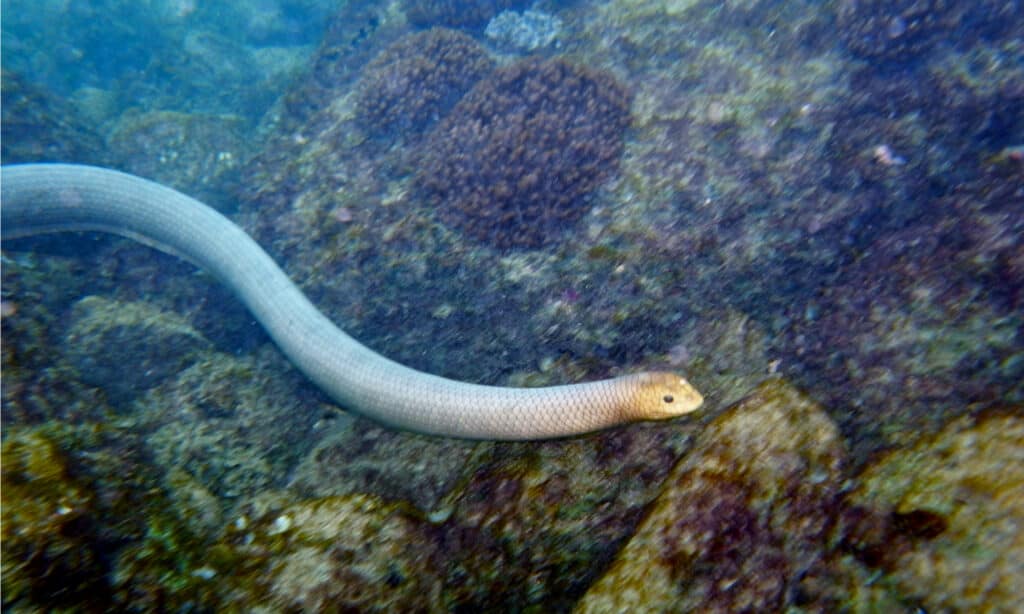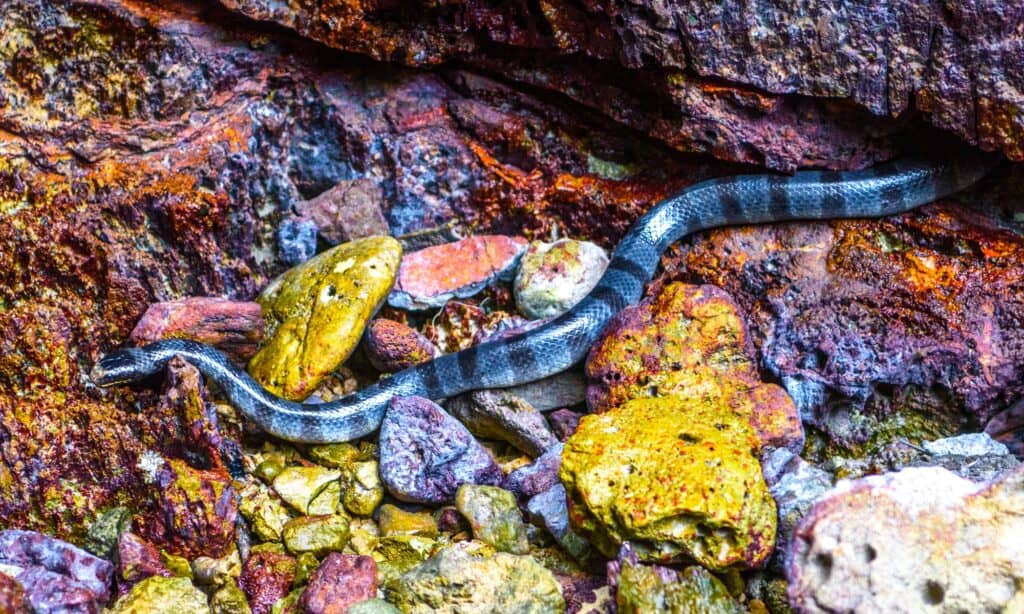Sea snakes are among the most interesting reptiles in the world! Not only are they beautiful, but they spend the majority of their lives in the ocean. Even more, sea snakes give birth to live young in the water, unlike any other group of snakes. With so much time spent in the water, it may seem like they can breathe it like a fish! Today, we will learn exactly how sea snakes breathe?
Let’s get started!
Do sea snakes breathe water or air?

Sea snakes breathe through a single lung but supplement their oxygen through special adaptations.
©Rich Carey/Shutterstock.com
Sea snakes, like most creatures, need oxygen to survive. There are two main ways that large animals get oxygen: through lungs or through gills. Lungs allow animals to pull the oxygen from the air around them, while gills allow animals to pull the oxygen that has been dissolved in the water. Sea snakes use a lung, meaning they “breathe” air.
As a general rule, snakes have one functioning lung. In the case of sea snakes, that lung is extremely long and is contracted to bring air into their body. When they aren’t breathing, the entrance to the lung (the glottis) is closed.
How long can a sea snake hold its breath?
Sea snakes spend their entire lives in or around the water, making it quite important for them to be able to hold their breath! These snakes can hold their breath for a long time in order to dive and hunt. The exact length of time that a snake can hold its breath actually depends on the species (there are over 60 sea snakes). Generally, a sea snake can dive for up to 30 minutes, although some special snakes can stay submerged for 8 hours. For snakes that can stay submerged for 8 hours, a special biological adaption is essential.
Sea snake adaptations to help them underwater

Some sea snakes can absorb oxygen through their skin, allowing them to dive for hours at a time.
©Sahara Frost/Shutterstock.com
There are a few biological adaptations that sea snakes have that allow them to breathe better while in the ocean. Let’s go over them.
Breathing through their skin
One of the unique aspects of some true sea snakes is their ability to release and absorb gasses through their skin. In some snake species, they can absorb up to 33% of the oxygen they need solely through their skin. Additionally, they can get rid of 90% of the carbon dioxide in their bodies through their skin. Together, this absorption and release allow true sea snakes to stay submerged for much, much longer than just taking a breath.
Nose valves
A small adjustment that sea snakes have is the ability to close their noses through special flaps or valves. When they submerge, these little valves close, making sure that water can’t get into their noses when they are deep-diving for prey.
How deep can sea snakes dive?

Some sea snakes have been recorded at depths of 800 feet.
©iStock.com/Eagle2308
With both of these adaptations, some sea snakes can dive incredibly deep. Some snakes have even been recorded at depths of up to 800 feet! Although this is amazing, sea snakes don’t generally dive to these depths unless they have a reason (usually in search of specific prey). Most of the time, sea snakes prefer to stay near the shallows along the coast.
The photo featured at the top of this post is © Rich Carey/Shutterstock.com
Discover the "Monster" Snake 5X Bigger than an Anaconda
Every day A-Z Animals sends out some of the most incredible facts in the world from our free newsletter. Want to discover the 10 most beautiful snakes in the world, a "snake island" where you're never more than 3 feet from danger, or a "monster" snake 5X larger than an anaconda? Then sign up right now and you'll start receiving our daily newsletter absolutely free.
Thank you for reading! Have some feedback for us? Contact the AZ Animals editorial team.






